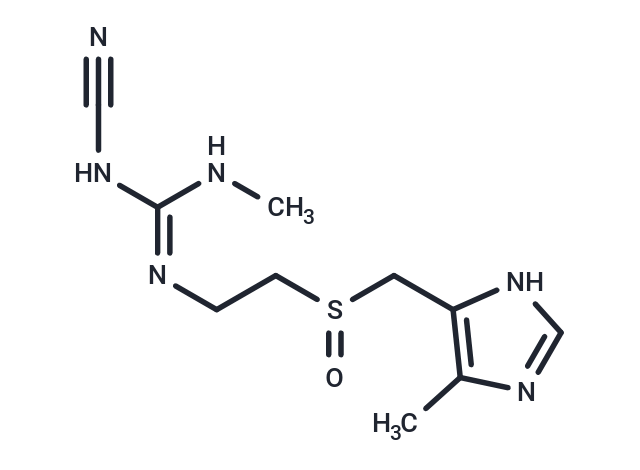Shopping Cart
Remove All Your shopping cart is currently empty
Your shopping cart is currently empty
Cimetidine sulfoxide (Cimetidine sulphoxide), a metabolite of Cimetidine, is a histamine H2-receptor antagonist with potential applications in treating peptic ulcer disease and upper gastrointestinal hemorrhage [1].


| Description | Cimetidine sulfoxide (Cimetidine sulphoxide), a metabolite of Cimetidine, is a histamine H2-receptor antagonist with potential applications in treating peptic ulcer disease and upper gastrointestinal hemorrhage [1]. |
| In vitro | Active transport of Cimetidine across the rat small intestine occurs at lower substrate concentrations (40 and 200 μM) but becomes obscured by passive transfer at higher concentrations (400 μM). Following specific incubations, Cimetidine sulfoxide is present[2]. |
| In vivo | The enantiomeric composition of Cimetidine sulfoxide in male Wistar rats' urine (24 h) was analyzed following a 30 mg/kg oral dose of Cimetidine (po), resulting in an enantiomeric ratio of (+/-) 57:43[3]. |
| Molecular Weight | 268.34 |
| Formula | C10H16N6OS |
| Cas No. | 54237-72-8 |
| Smiles | CN\C(NC#N)=N/CCS(=O)Cc1[nH]cnc1C |
| Storage | Powder: -20°C for 3 years | In solvent: -80°C for 1 year | Shipping with blue ice/Shipping at ambient temperature. | |||||||||||||||||||||||||||||||||||
| Solubility Information | DMSO: 83.33 mg/mL (310.54 mM), Sonication and heating to 60℃ are recommended. | |||||||||||||||||||||||||||||||||||
| In Vivo Formulation | 10% DMSO+40% PEG300+5% Tween-80+45% Saline: 3.3 mg/mL (12.3 mM), Sonication is recommeded. Please add the solvents sequentially, clarifying the solution as much as possible before adding the next one. Dissolve by heating and/or sonication if necessary. Working solution is recommended to be prepared and used immediately. The formulation provided above is for reference purposes only. In vivo formulations may vary and should be modified based on specific experimental conditions. | |||||||||||||||||||||||||||||||||||
Solution Preparation Table | ||||||||||||||||||||||||||||||||||||
DMSO
| ||||||||||||||||||||||||||||||||||||
| Size | Quantity | Unit Price | Amount | Operation |
|---|

Copyright © 2015-2026 TargetMol Chemicals Inc. All Rights Reserved.